Dunhuang manuscripts
The Dunhuang manuscripts are a cache of important religious and secular documents discovered in the Mogao Caves of Dunhuang, China, in the early 20th century. Dating from late 4th to early 11th centuries, the manuscripts include works ranging from history and mathematics to folk songs and dance. There are also many religious documents, most of which are Buddhist, but other religions including Daoism, Nestorian Christianity and Manichaeism are also represented. The majority of the manuscripts are in Chinese. Other languages represented are Khotanese, Kuchean, Sanskrit, Sogdian, Tangut, Tibetan, Old Uyghur language, Prakrit and Old Turkic.[1] The manuscripts are a major resource for academic studies in a wide variety of fields including history, religious studies, linguistics, and manuscript studies.[2]
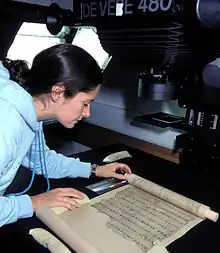
History
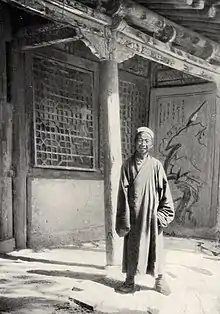
The Dunhuang manuscripts were kept in a cave, the so-called Library Cave, walled off sometime early in the 11th century. The documents in the cave were discovered in by the Daoist monk Wang Yuanlu, who was interested in restoring the Mogao Caves, on June 25, 1900.[3] In the next few years, Wang took some manuscripts to show to various officials who expressed varying level of interest, but in 1904 Wang re-sealed the cave following an order by the governor of Gansu concerned about the cost of transporting these documents. From 1907 onwards, Wang began to sell them to Western explorers, notably Aurel Stein and Paul Pelliot. According to Stein who was the first to describe the cave in its original state:
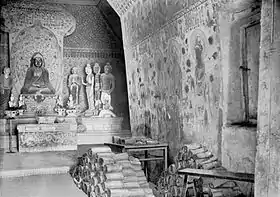
Heaped up in layers, but without any order, there appeared in the dim light of the priest's little lamp a solid mass of manuscript bundles rising to a height of nearly ten feet, and filling, as subsequent measurement showed, close on 500 cubic feet. The area left clear within the room was just sufficient for two people to stand in.[4]
Stein had the first pick and he was able to collect around 7,000 complete manuscripts and 6,000 fragments for which he paid £130, although these include many duplicate copies of the Diamond and Lotus Sutras. Pelliot took almost 10,000 documents for the equivalent of £90, but, unlike Stein, Pelliot was a trained sinologist literate in Chinese, and he was allowed to examine the manuscripts freely, so he was able to pick a better selection of documents than Stein. Pelliot was interested in the more unusual and exotic of the Dunhuang manuscripts, such as those dealing with the administration and financing of the monastery and associated lay men's groups. Many of these manuscripts survived only because they formed a type of palimpsest whereby papers were reused and Buddhist texts were written on the opposite side of the paper. Hundreds more of the manuscripts were sold by Wang to Otani Kozui and Sergey Oldenburg.[5][6]
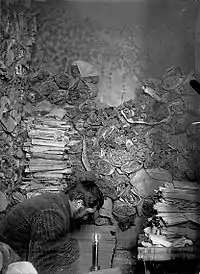
Scholars in Beijing were alerted to the significance of the manuscripts after seeing samples of the documents in Pelliot's possession. Due to the efforts of the scholar and antiquarian Luo Zhenyu, most of the remaining Chinese manuscripts were taken to Beijing in 1910 and are now in the National Library of China. Several thousands of folios of Tibetan manuscripts were left in Dunhuang and are now located in several museums and libraries in the region.[7] Rumours of caches of documents taken by local people continued for some time, and a cache of documents hidden by Wang from the authorities was later found in the 1940s.[8] Those purchased by Western scholars are now kept in institutions all over the world, such as the British Library and the Bibliothèque nationale de France. All of the manuscript collections are being digitized by the International Dunhuang Project, and can be freely accessed online.
Studies
While most studies use Dunhuang manuscripts to address issues in areas such as history and religious studies, some have addressed questions about the provenance and materiality of the manuscripts themselves. Various reasons have been suggested for the placing of the manuscripts in the library cave and its sealing. Aurel Stein suggested that the manuscripts were "sacred waste", an explanation that found favour with later scholars including Fujieda Akira.[9] More recently, it has been suggested that the cave functioned as a storeroom for a Buddhist monastic library,[10] though this has been disputed.[11]
The reason for the cave's sealing has also been the subject of speculation. A popular hypothesis, first suggest by Paul Pelliot, is that the cave was sealed to protect the manuscripts at the advent of an invasion by the Xixia army, and later scholars followed with the alternative suggestion that it was sealed in fear of an invasion by Islamic Kharkhanids that never occurred.[10] Even though cave 16 could easily have been enlarged or extended to cave 17, Yoshiro Imaeda has suggested cave 16 was sealed because it ran out of room.[12]
Liu Bannong compiled Dunhuang Duosuo (敦煌掇瑣 "Miscellaneous works found in the Dunhuang Caves"), a pioneering work about the Dunhuang manuscripts.
Languages and scripts
The variety of languages and scripts found among the Dunhuang manuscripts is a result of the multicultural nature of the region in the first millennium AD.[13] The largest proportion of the manuscripts are written in Chinese, both Classical and, to a lesser extent, vernacular Chinese. Most manuscripts, including Buddhist texts, are written in Kaishu or 'regular script', while others are written in the cursive Xingshu or 'running script'. An unusual feature of the Dunhuang manuscripts dating from the 9th and 10th centuries is that some appear to have been written with a hard stylus rather than with a brush. According to Akira Fujieda this was due to the lack of materials for constructing brushes in Dunhuang after the Tibetan occupation in the late 8th century.[14]
The Dunhuang manuscripts represent some of the earliest examples of Tibetan writing. Several styles are represented among the manuscripts, forebears of the later Uchen (dbu can) and Ume (dbu med) styles.[15] Both Old Tibetan and Classical Tibetan are represented in the manuscripts, as well as the undeciphered Nam language and a language that some have identified as the Zhang-zhung language.
Other languages represented are Khotanese, Sanskrit, Sogdian, Tangut, Tibetan, Old Uyghur language, and Hebrew,[16] as well as Old Turkic.
Buddhist texts
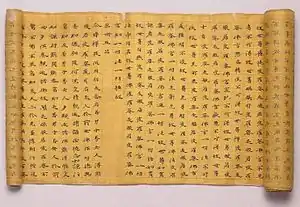
By far the largest proportion of manuscripts from the Dunhuang cave contain Buddhist texts. These include Buddhist sutras, commentaries and treatises, often copied for the purpose of generating religious merit.[17] Several hundred manuscripts have been identified as notes taken by students,[18] including the popular Buddhist narratives known as bian wen (變文).[19] Much of the scholarship on the Chinese Buddhist manuscripts has been on the Chan (or Zen) texts, which have revolutionized the history of Chan Buddhism.[20] Among the Tibetan Buddhist manuscripts, the texts of early Tibetan tantric Buddhism, including Mahayoga and Atiyoga or Dzogchen have been the subject of many studies.[21]
Other textual genres
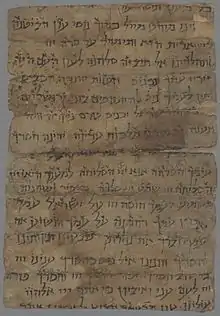
- Non-Buddhist religious texts
- Taoist texts, including the Hua Hu Jing, and the Xiang'er commentary to the Tao Te Ching
- Jewish Selihot prayers
- Nestorian Christian texts[22]
- Manichaean texts
- Social documents, such as contracts, account books and loan receipts
- Philosophy, notably the Confucian classics, including an ancient edition of Analects commented by Huang Kan (皇侃), and ancient editions of the Shang Shu
- Literature, including Chinese folk songs and Classical poetry
- History, both official and local
- Geography, including the Wang wu tianzhu guo chuan
- Medicine, including treatments for plagues and illnesses.[23] The medical texts include a fragment of Bencaojing jizhu, one of the earliest Chinese pharmacological texts.
- Astronomy, including the Dunhuang star map
- Mathematics
- Divination, including the Irk Bitig
- Dictionaries, including fragments of the Qieyun
- Music scores and dance notations
- Recreational games (the Dunhuang Go Classic)
See also
- Cairo Geniza, similar cache of ancient religious and secular documents
- Silk Road transmission of Buddhism
- Zhuying ji, partially recovered poetry manuscript from the period of Wu Zetian
References
- Jacques Gernet (31 May 1996). A History of Chinese Civilization. Cambridge University Press. pp. 19–. ISBN 978-0-521-49781-7.
- Ponampon, Phra Kiattisak (2019). Dunhuang Manuscript S.2585: a Textual and Interdisciplinary Study on Early Medieval Chinese Buddhist Meditative Techniques and Visionary Experiences. Cambridge: University of Cambridge. p. 14. Retrieved 25 February 2019.
- Wenjie Duan (1 January 1994). Dunhuang Art: Through the Eyes of Duan Wenjie. Abhinav Publications. p. 52. ISBN 978-81-7017-313-7.
- Opening of the hidden chapel M. Aurel Stein, Ruins of Desert Cathay: Vol II
- Paragraph 1 in Neil Schmid "Tun-huang Literature", chapter 48 in Mair 2001.
- Trudy Ring; Noelle Watson; Paul Schellinger, eds. (1996). Asia and Oceania: International Dictionary of Historic Places. Routledge. p. 244. ISBN 978-1884964046.
- "Tibetan Dunhuang Manuscripts in China" in The Bulletin of the School of Oriental and African Studies 65.1 (2002): 129–139. | "The Whereabouts of the Tibetan Manuscripts from Dunhuang". 2007-07-26.
- Peter Hopkirk (2006). Foreign Devils on the Silk Road. John Murray. ISBN 978-0-7195-6448-2.
- Fujieda, Akira. 1969. "The Tun-huang Manuscripts: A General Description, Part II." In Zimbun: Memoirs of the Research Institute for Humanistic Studies, Kyoto University 10: 17–39.
- Rong Xinjiang (1999). "The Nature of the Dunhuang Library Cave and the Reasons for its Sealing". Cahiers d'Extrême-Asie. 11: 247–275. doi:10.3406/asie.1999.1155.
- Imaeda, Yoshirō. 2008. "The Provenance and Character of the Dunhuang Documents." Memoirs of the Toyo Bunko 66: 81–102. "The Provenance and Character of the Dunhuang Documents" (PDF). Archived from the original (PDF) on 2012-04-14.
- Imaeda, Yoshirō. 2008. "The Provenance and Character of the Dunhuang Documents". Memoirs of the Toyo Bunko 66: 98 "The Provenance and Character of the Dunhuang Documents" (PDF). Archived from the original (PDF) on 2012-04-14.
- Takata, Tokio 高田時雄. 2000. "Multilingualism at Tun-huang". Acta Asiatica, Bulletin of the Institute of Eastern Culture 78: 49–70. "Multilingualism in Tun-huang'" (PDF).
- FUJIEDA, Akira. 1968. "Sutain Tonkō shūshū e-iri Kannongyō sasshi (S.6983): Tonkō ni okeru mokuhitsu no shiyō" スタイン蒐集絵入り〈観音経〉冊子(S.6983)—— 敦煌における木筆の使用. Bokubi 墨美 177: 3–45.
- van Schaik, Sam (2012). 'The Origin of the Headless Style (dbu med) in Tibet.' Tibeto-Burman Languages IV, edited by Nathan Hill. Leiden: Brill, 2012.
- Susan Whitfield (2004). The Silk Road: Trade, Travel, War and Faith. London: British Library Press, 2004.
- Giles, Lionel (1944). Six Centuries at Dunhuang.
- Mair, Victor (1981). Lay Students and the Making of Written Vernacular Narrative: An Inventory of the Tun-huang Manuscripts. CHINOPERL Papers No. 10.
- Mair, Victor (1983). Tun-Huang Popular Narratives. Cambridge University Press.
- Adamek, Wendi (2007). The Mystique of Transmission: On an Early Chan History and Its Contexts. Columbia University Press.
- van Schaik, Sam (2008). A Definition of Mahāyoga: Sources from the Dunhuang Manuscripts (PDF). Tantric Studies 1. pp. 45–88.
- David Jonsson (May 2006). Islamic Economics and the Final Jihad. Xulon Press. pp. 479–. ISBN 978-1-59781-980-0.
- "Medicine on the Silk Road".
Cited works
- Mair, Victor H. (ed.) 2001. The Columbia History of Chinese Literature. New York: Columbia University Press. ISBN 0-231-10984-9. (Amazon Kindle edition.)
Further reading
- Les grottes de Touen-Houang 1920. Les grottes de Touen-Houang : vol.1 Les grottes de Touen-Houang : vol.2 Les grottes de Touen-Houang : vol.3 Les grottes de Touen-Houang : vol.4 Les grottes de Touen-Houang : vol.5 Les grottes de Touen-Houang : vol.6
- Воробьева-Десятовская М.И., Зограф И.Т., Мартынов А.С., Меньшиков Л.Н., Смирнов Б.Л. Описание китайских рукописей Дуньхуанского фонда Института народов Азии. В 2 выпусках / Ответственный редактор Л.Н.Меньшиков. М.: «Наука», ГРВЛ, 1967. Вып. 2. 687 с.
- Воробьева-Десятовская М.И., Гуревич И.С., Меньшиков Л.Н., Спирин В.С., Школяр С.А. Описание китайских рукописей Дуньхуанского фонда Института народов Азии. В 2 выпусках / Ответственный редактор Л.Н.Меньшиков. М.: ИВЛ, 1963. Вып. 1. 778 с.
- Китайские рукописи из Дуньхуана: Памятники буддийской литературы сувэньсюэ / Издание и предисловие Л.Н.Меньшикова. М.: ИВЛ, 1963. (Памятники литературы народов Востока. Тексты. Большая серия. XV.). 75 с.